Film of the Week: Ready Player One
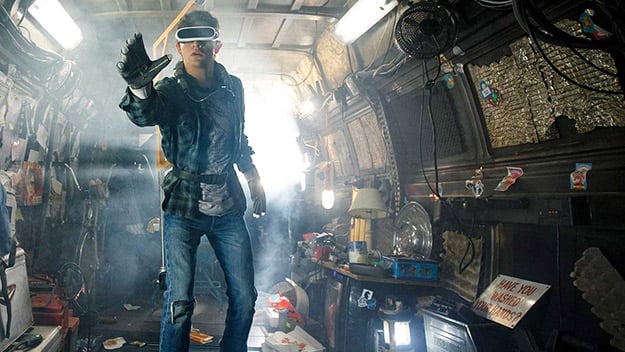
Being of a certain age, I can remember the time when people started pointing out that such and such a film was “like a video game”—roughly around the same time that they first started comparing movies to theme park experiences. Steven Spielberg surely remembers that moment too, because he played a huge part in bringing about that shift in cinema—the theme park analogy nowhere being more overt than in Jurassic Park (1993).
How innocent, how economical, that film now looks in its use of CGI: a sparing amount of digital illusion mixed in with live action and animatronics to produce a genuine sense of, to use a classically Spielbergian word, “wonder.” Twenty-five years later, CGI has engulfed blockbuster cinema to the extent that VFX specialists increasingly strain to produce the effect of the marvelous or the new. You can imagine Spielberg waking up in the morning to the rueful feeling that the magic has gone, and that it’s partly his fault—then shrugging and going off to attend to more earthbound business like The Post.
Some people will see Ready Player One as a case of Spielberg reclaiming his crown as a grand master of spectacle; for others, it will seem a cacophony of frenetic, joyless clamor, a CGI-era counterpart to his 1941. Ready Player One has something of both, and that is perhaps its point. On one hand, the film is Spielberg’s most purely hedonistic in terms of spectacle, pace and sheer agitation. On the other, it’s a film that constantly asks, perhaps too overtly: is this all there is? Is this where all this technological brilliance has left us? That arguably makes Ready Player One a blockbuster in bad faith, constantly undermining and defusing the pleasures it purveys. But it’s fascinating to see a master film-maker in the (at the very least) autumnal phase of his career making a work that’s at once so boisterously crowd-pleasing and so extremely neurotic.
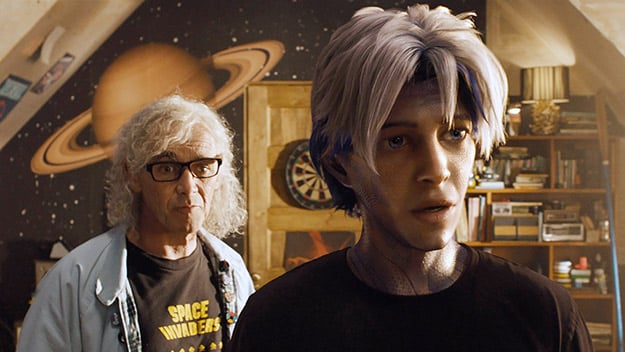
Based on the science-fiction best-seller by Ernest Cline—who has scripted the film together with Zak Penn—the movie is set in Columbus, Ohio in 2045, in an America transformed by both droughts and “bandwidth riots” (you can only imagine what they are, but we should probably prepare ourselves). The action begins in a slum area, the “Stacks,” where containers are piled up in towers as living quarters; in a vertiginous opening sequence, we’re wheeled though a world in which almost everyone we see is strapped into virtual reality headsets. “These days, reality’s a bummer,” explains young hero Wade Watts (Tye Sheridan) in voiceover, “that’s why everyone’s trying to escape.” As we soon see, the universal flight from bleak, subsistence-level reality and into the escapist pleasures of VR is itself a bummer: gaming has become a universal addiction destroying people’s minds and draining their economic resources. Profiting handsomely, meanwhile, is a company named IOI (Innovative Online Industries), which employs its own militia and places overdrawn subscribers in “Loyalty Centers”: basically, private debtors’ prisons with a touch of Guantanamo, where they’re forced to work off their debt by playing games in cell-like pods.
Even so, gaming still retains a utopian dimension for those who believe. In the form of his cool-cat digital avatar Parzival—depicted as a kind of punkier Marty McFly processed through the visual textures of the Final Fantasy movie—Wade spends most of his time in a virtual heaven, a massive gaming world named the Oasis. It’s essentially an infinite multi-dimensional virtual Vegas where all pleasures are available, from battle planets to retro disco environments, and even the possibility of climbing Everest, “with Batman!” (there are spicier attractions too, but they don’t interest Wade: this is a family movie).
The Oasis is the creation of a legendary games innovator named James Halliday (Mark Rylance), a shy, reclusive, troubled visionary who’s presented as a sort of Zuckerbergo-Gatesian über-wiz, yet essentially an innocently benign overgrown child-god. When Halliday dies, he announces that he has hidden three Easter eggs in the shape of keys in the Oasis, and that fabulous rewards await whoever finds them. The whole world sets out in search of the keys, from individual “Gunters” or egg-hunters, to the massed forces of IOI, whose boss Nolan Sorrento (Ben Mendelsohn) knows that they are his gateway to total control of the Oasis and infinite wealth. But there are also committed seekers like Wade/Parzival, who will go about the egg-hunt with a pure heart, a sharp brain and total belief in the joyous ludic spirit of Halliday’s vision.
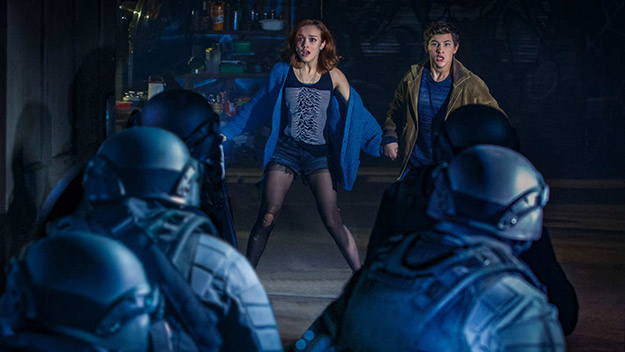
So this is essentially Charlie and the Chocolate Factory for gamers, with Halliday as Willie Wonka, making his golden tickets that bit harder to acquire. The race for the keys is not terribly interesting as narrative, essentially a device for taking us through as many spectacular game environments as possible. What’s extraordinary about Ready Player One is how crammed and breathless the film is, like the Oasis itself. Parzival’s first challenge is a road race in which participants have to dodge various lethal obstacles including rampaging T. Rexes and a Kong-like ape, while contestants killed in mid-race explode in showers of gold coins.
What guides Parzifal on his path is his obsessively scholarly study of the life of Halliday, recorded in a museum overseen by the Curator, a silver-voiced robot butler with distinct echoes of the automata in Spielberg’s A.I. Now you might think, on the evidence so far, that Ready Player One sounds a little derivative. It is: this is one of the most thoroughly unoriginal films you’ve ever seen. But that’s the point: it’s as comprehensive an example of sampled cinema as the mainstream has yet given us.
Spielberg has packed the film with an entire history of cinematic pop culture since the 80s: the decade when gaming started to take over the cultural consciousness; the moment before CGI transformed cinema; and a period that, in recent retro fictions such as It and Stranger Things, has become a mythical age of lost innocence. In Ready Player One, along with references to the entire history of video games—even including the invention of Easter eggs—we get nods to Blade Runner, Alien, Tron, Beetlejuice, Chucky… There’s even a visual nod to Jack Slater, Schwarzenegger’s apocryphal alter ego in the wildly self-reflexive Last Action Hero, and a shout-out to a former ally in the ’80s “cinema of wonder,” in the form of a much-cherished artifact called a “Zemeckis Cube.” There’s even an extraordinary sequence in which Parzifal and his allies enter another film entirely. I won’t say which, but it’s a much-revered classic that creates its own claustrophobic universe. For some viewers, what Spielberg does with it will seem an act of outright sacrilege; I felt it was done with wit and chutzpah in a way that at the very least is forgivable, and is certainly fueled by fond homage.
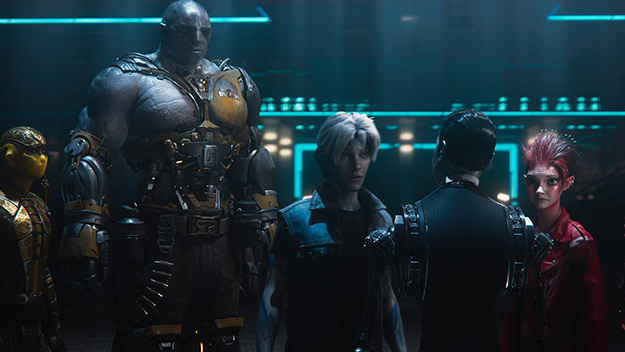
There’s a certain nerd pedantry, however, to the film’s omnivorousness. At one point, Sorrento tries to catch Wade out with trick references to John Hughes movies: Wade passes with flying colors whereas Sorrento, who has no true love of pop culture, has to be prompted through an earpiece by his minions. This is a truly strange moment for several many reasons. One, it reminds us that the Hughes cycle, and similar teen movies of the era, have become cherished as an embodiment of Edenic purity before the cynical CGI-fuelled rot set in; we’re also meant to believe that knowledge of such films embodies some sort of spiritual authenticity (Wade sees through Sorrento with the clear vision of a believer because “a fanboy knows a hater”). But this sequence itself recycles a staple of teen movie tropes since time immemorial: Sorrento’s the corporate square, the breadhead, trying to capitalize on the idealism of the young: he’s the Man plotting to synthesize acid commercially, or a record company executive out to milk the kids’ music… It’s a curiously ’60s moment in this futuristic movie.
Meanwhile, the film constantly reveals its conservative mindset. Parzifal finds a rival, then an ally, in a formidable female gamer named Art3mis, styled as a streamlined punkette with big anime eyes and a Sonic Hedgehog hairstyle. She’s a fairly routine figure of Pop Feminism—the smarter, tougher independent girl who’s constantly challenging the hero. But she then becomes Wade’s love object and his ticket to maturity and success: her real-world human incarnation proves to be a soft-edged, entirely unthreatening young woman named Samantha (Olivia Cooke), who’s sensitive about her own supposedly imperfect appearance, although the film gives her just a port-wine facial mark that you barely notice. Meanwhile a woman who was Halliday’s lost love and who provides the key to his past is no more than a handy human “Rosebud.”
We also get Parzival’s VR buddy, warrior and inventor Aech, who takes the form of a lumbering orc-like giant, and represents a version of the clichéd big-hearted black buddy—which in human form, he turns out to be, again with a twist that’s unlikely to worry anyone very much. Factor in two ninja-like sidekicks who turn out to be Asian games nerds, and you have a film mired in cliché, even while it constantly urges us to look beyond the obvious.
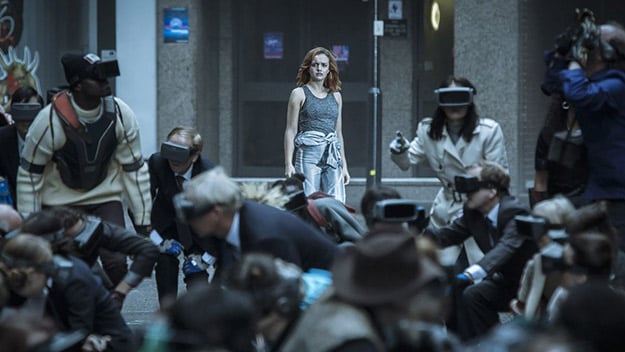
For all its ferocious energy, Ready Player One strikes me as the product of a cinema of exhaustion—it’s a film about having come too far and being at the end of something, where extraordinary things no longer mean much, or have become toxic. It does have serious questions to ask about where the cinema of spectacle—and its more cynical cousin, the gaming industry—have taken us today. The film is so insanely overloaded—with event, image, action, detail—that it becomes an essay on the difficulty of finding meaning in an age of overkill.
The film’s spectacular effects no longer figure as revelations of the new, but simply trigger recognitions of the already-seen: even a climactic battle of armies seems more a generic nod than a significant event in itself, an allusion to the clash of multitudes that’s been a mandatory blockbuster trope since The Lord of the Rings and the development of Massive crowd-simulation software. Most distressingly from a cinephile point of view, Ready Player One seems to say that popular cinema no longer means much in itself but has primarily become a generator of iconography to be recycled more lucratively in games.
Paradoxically, the very excess that the film critiques does make Ready Player One quite exhilarating, although its pleasures are substantially produced by ironic framing. It’s the kind of movie that will make some critics instantly want to go and write a long essay—but then we too are probably caught up in our own nostalgia for the 80s and the golden age of theorizing on the wonders of post-modernism.
In the end, the film’s warning about escapism is rather neatly resolved with the sign-off, “People need to spend more time in the real world.” Spielberg manages to have his virtual cake and eat it, but then we all love a contradictory text. The thing that most worries me, however, is that while the film pays testimony to the God-like brilliance of Halliday as a paragon of boundless imagination, the world depicted here leaves no room for the imagination. Aech does a bit of tinkering on his own robots, while Wade gets to decide whether he’ll dress his avatar as Prince, Michael Jackson or (wait for it) Buckaroo Banzai. But no-one really gets to use their imagination in the Oasis, a world laid on with all its possibilities pre-programmed. And in the hyper-programmed, visually intense, pixel-saturated world of Ready Player One itself, there doesn’t seem to be much room for viewers to use their imaginations either. For that, you might have to read the novel instead.
Jonathan Romney is a contributing editor to Film Comment and writes its Film of the Week column. He is a member of the London Film Critics Circle.







